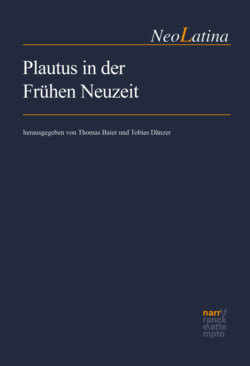Читать книгу Plautus in der Frühen Neuzeit - Группа авторов - Страница 24
4. The Camels’ Origin
ОглавлениеCamerariusCamerarius d.Ä., Joachim’ 1552 edition begins with a preface explaining why his new text of Plautus is important:1
Adminicula quaedam habuimus duorum librorum veterum quidem illorum sed quos librariorum inscitia et futilitas foede depravasset. Horum alteram nacti fuimus de bibliotheca praestantis dignitate et doctrina viri Viti Werleri Franci, cui pleraque debemus eorum quae a nobis fuerunt correcta.
Georgii autem Fabricii candor eximius et benevolentia summa erga nos, de incredibili studio diligentiae suae, communicavit nobiscum nuper suum quoque librum, in quem congesserat quicquid perquirere legendo potuit, quod ad Plautinarum fabularum tam emendationem quam explicationem aliquid momenti haberet.
Caetera sunt considerationis et curae ac studii nostri.
I got a certain amount of help from two books. They’re both old but scandalously disfigured by the idiocy and laziness of the scribes who copied them out. I got one of them from the library of Veit WerlerWerler, Veit of Franconia, who is both a scholar and a gentleman. I owe quite a few of my textual corrections to it.
Moreover, Georg FabriciusFabricius, Georg’ outstanding candor and kindness toward me, from the incredible enthusiasm of his diligence, recently shared his book with me, which he’d packed with whatever he could find out in his reading that had some bearing on emending and elucidating Plautus’ plays.
I alone am responsible for everything else in this book.
Because the 1552 text is printed as a single block, my paragraphing here is meant to clarify that CamerariusCamerarius d.Ä., Joachim is not talking about two books, but three. The first is the Vetus, but the second is not, as is sometimes thought, “Georg FabriciusFabricius, Georg’ book.” FabriciusFabricius, Georg’ book is a third book, a collection of fragments that was supposed to be reprinted in CamerariusCamerarius d.Ä., Joachim’ edition but accidentally got left out; I will come back to it in ch. 8.2 The point to grasp here is that the “two books” CamerariusCamerarius d.Ä., Joachim says he got help from are camels B and C – that is, the Vetus and the Decurtatus.
We know a lot about the origins of the Vetus because CamerariusCamerarius d.Ä., Joachim had written in greater detail about it in the preface to the 1545 partial edition of Plautus he’d published in Leipzig.3 As he explains there, once upon a time Martin PollichPollich, Martin (1455–1513), the first rector of Wittenberg University, had owned it. In 1512, PollichPollich, Martin gave it Veit WerlerWerler, Veit, CamerariusCamerarius d.Ä., Joachim’ former professor at Leipzig mentioned above, and in 1525 the humanist Michael RotingRoting, Michael (1494–1588), WerlerWerler, Veit’s nephew, took it from WerlerWerler, Veit’s bookcase and gave it to CamerariusCamerarius d.Ä., Joachim. By 1552, therefore, when CamerariusCamerarius d.Ä., Joachim published his complete Plautus in Basel, he had had the manuscript in his possession for 27 years.4
The situation with the Decurtatus is entirely different. CamerariusCamerarius d.Ä., Joachim claims he got “help” (adminicula) from both manuscripts, but his claim does not match the evidence. As Ritschl puts it,
A glance at any page of my edition of BacchidesBacchides or at the notes in TaubmannTaubmann, Friedrich, GruterGruter, Jan, and PareusPareus, Johann Philipp on any scene at all in any one of Plautus’ twenty comedies can show that CamerariusCamerarius d.Ä., Joachim didn’t mention 1 % of its manuscript variants.
The editor of Ritschl’s Kleine Schriften interjects, “No kidding – not even 0.1%!”5
Equally strange is where and when CamerariusCamerarius d.Ä., Joachim got the Decurtatus in the first place. Thanks to a subscription written on its first page, we know that the manuscript had once belonged to the library of the St. Corbinian abbey at Freising (Bavaria). But CamerariusCamerarius d.Ä., Joachim does not say that or anything else about how it came into his possession. In his facsimile edition of the Decurtatus, Zangemeister complained,
I’ve completely failed to find out by what rights CamerariusCamerarius d.Ä., Joachim called this “his” manuscript or what year he got it in, though it is clear that this [1545 prefatory] letter is his first mention of it. He chose to say nothing of its origins.6
A few years ago, Giorgia Bandini echoed him: “We cannot know how and when, once he had also gotten hold of C, CamerariusCamerarius d.Ä., Joachim compared the two manuscripts.” We have thus made no progress since Ritschl, who wrote in 1848 “By what vicissitudes it reached CamerariusCamerarius d.Ä., Joachim, is unknown,” and who ended an essay shortly before his death, “Anyone who can shed light on this mystery will be most appreciated.”7
I’m pleased to say the first letter I found in 2017 might finally shed light on this mystery.
